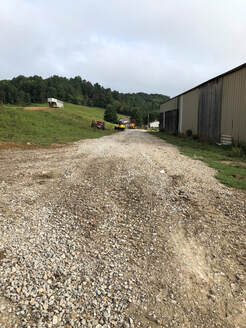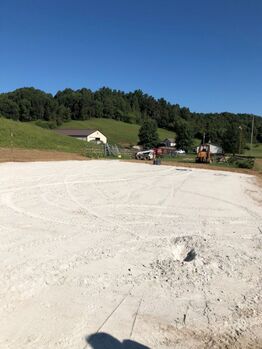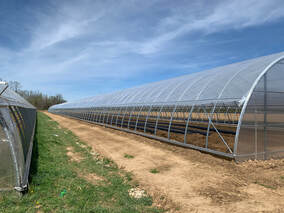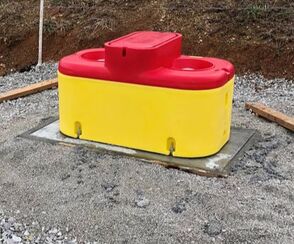
Access Road
Access roads can be installed in heavily traveled locations that can become rutted or to prevent erosion to gain access from one place to another. This type of practice is usually installed between feed storage areas and to the feeding site or watering facility. The road is constructed by a layer of geotextile fabric place on the graded surface of road, then the fabric has 8 inches of ODOT 304'S stone placed on top.
Access roads can be installed in heavily traveled locations that can become rutted or to prevent erosion to gain access from one place to another. This type of practice is usually installed between feed storage areas and to the feeding site or watering facility. The road is constructed by a layer of geotextile fabric place on the graded surface of road, then the fabric has 8 inches of ODOT 304'S stone placed on top.

Fencing
Fence is constructed barrier mainly for containment of livestock. Fencing allows you to keep livestock out of sensitive areas such streams, wooded areas, and areas that can impact water quality. By limiting livestock to those areas can reduce the amount of erosion on streambanks and sediment entering the stream, minimize nutrient and manure runoff that could pollute the stream. Some examples of fence that is most commonly used is barb wire, high-tensile wire, wooden board and woven wire.
Fence is constructed barrier mainly for containment of livestock. Fencing allows you to keep livestock out of sensitive areas such streams, wooded areas, and areas that can impact water quality. By limiting livestock to those areas can reduce the amount of erosion on streambanks and sediment entering the stream, minimize nutrient and manure runoff that could pollute the stream. Some examples of fence that is most commonly used is barb wire, high-tensile wire, wooden board and woven wire.

Heavy Use Area Protection
Heavy use area protection is a stone pad in a heavily used area in pastures or near barns that is affected by livestock rutting. Grass cover is hard to maintain in these areas so this allows better access to livestock feeding and watering areas. These pads are constructed by using geotextile fabric than covered by 8 inches of ODOT 304's and 3 inches of limestone screenings for a total pad thickness of 11 inches.
Heavy use area protection is a stone pad in a heavily used area in pastures or near barns that is affected by livestock rutting. Grass cover is hard to maintain in these areas so this allows better access to livestock feeding and watering areas. These pads are constructed by using geotextile fabric than covered by 8 inches of ODOT 304's and 3 inches of limestone screenings for a total pad thickness of 11 inches.

High Tunnel System
High Tunnel is an enclosed polyethylene, polycarbonate, plastic, or fabric covered structure that is used to cover and protect crops from sun, wind, excessive rainfall, or cold, to extend the growing season in an environmentally safe manner. Producers plants in the same ground as they did before installation or can use raised beds or no higher than 12 inches. This practice usually incorporates micro irrigation to water plants.
High Tunnel is an enclosed polyethylene, polycarbonate, plastic, or fabric covered structure that is used to cover and protect crops from sun, wind, excessive rainfall, or cold, to extend the growing season in an environmentally safe manner. Producers plants in the same ground as they did before installation or can use raised beds or no higher than 12 inches. This practice usually incorporates micro irrigation to water plants.

Watering Facility
Watering facility is a established access point for livestock to obtain clean water for drinking. This practice includes the installation of a livestock pipeline from water source to facility. These facilities can be automatic waterer or large concrete stock tanks, and sites include a heavy use pad around them to prevent erosion. The water sources for watering facilities can vary from pressure system such as from a water tap, a spring development, to drawing water from a well.
Watering facility is a established access point for livestock to obtain clean water for drinking. This practice includes the installation of a livestock pipeline from water source to facility. These facilities can be automatic waterer or large concrete stock tanks, and sites include a heavy use pad around them to prevent erosion. The water sources for watering facilities can vary from pressure system such as from a water tap, a spring development, to drawing water from a well.